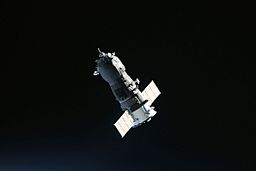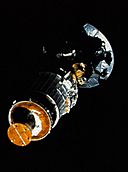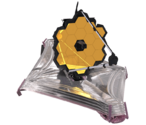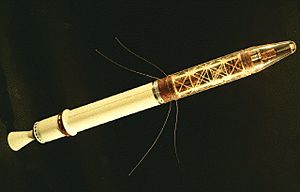Uncrewed spacecraft facts for kids
Bottom: The spaceplane Buran flew into space, orbited Earth, and landed without anyone on board in 1988 (left). A model of the James Webb Space Telescope (right).
Uncrewed spacecraft are vehicles that travel in space without any people inside them. They are also called robotic spacecraft. These spacecraft can work in different ways. Some are controlled by people from Earth, like a remote control car. Others can guide themselves. They have a list of tasks already programmed into them. They will do these tasks unless someone tells them to do something else. A robotic spacecraft that collects scientific information is often called a space probe or a space observatory.
Many space missions use robots instead of humans. This is because it costs less money and is safer. Also, some places in space, like Venus or near Jupiter, are too dangerous for humans right now. Planets like Saturn, Uranus, and Neptune are too far away for humans to reach with today's technology. So, robotic probes are the only way to explore them. Robots can also explore places that need to be kept very clean. Spacecraft can be cleaned completely to avoid bringing Earth germs. Humans cannot be cleaned in the same way because we have many tiny living things on and inside us.
The first uncrewed space mission was Sputnik. It was launched on October 4, 1957, and orbited Earth. Most satellites, landers (which land on planets), and rovers (which drive on planets) are robotic spacecraft. But not every uncrewed spacecraft is robotic. For example, a simple reflector ball in space is uncrewed but not robotic. Space missions with only animals on board, but no humans, are also called uncrewed missions.
Even spacecraft that carry people often have robotic parts. For example, the space stations Salyut 7, Mir, and the International Space Station's Zarya module could move and connect with other spacecraft by themselves. Uncrewed supply ships are now often used to bring food and other items to space stations with people on board.
Contents
History of Robotic Spacecraft
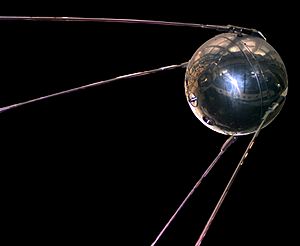
The first robotic spacecraft was launched by the Soviet Union (USSR) on July 22, 1951. It was a short flight into space, carrying two dogs named Dezik and Tsygan. Four more such flights happened later that year.
The first artificial satellite was Sputnik 1. The USSR launched it into Earth's orbit on October 4, 1957. It flew between 215 and 939 kilometers (134 and 583 miles) above Earth. On November 3, 1957, the USSR launched Sputnik 2. This spacecraft weighed 113 kilograms (249 pounds) and carried the first animal into orbit, a dog named Laika.
The United States quickly followed. They launched their first artificial satellite, Explorer 1, on January 31, 1958. It orbited Earth between 357 and 2,549 kilometers (193 and 1,373 miles) high. Explorer 1 was 205 centimeters (80.75 inches) long and 15 centimeters (6.00 inches) wide. It weighed 14 kilograms (30.8 pounds). Sputnik 1 was a sphere 58 centimeters (23 inches) wide and weighed 83.6 kilograms (184 pounds). Explorer 1 had sensors that found the Van Allen belts. This was a big scientific discovery at the time. Sputnik 1 did not have any scientific sensors. On March 17, 1958, the U.S. launched its second satellite, Vanguard 1. It was about the size of a grapefruit. As of 2016, it was still orbiting Earth.
The first attempt to send a probe to the Moon was the Luna E-1 No.1 on September 23, 1958. Many tries failed until January 4, 1959. On that day, Luna 1 flew around the Moon and then around the Sun.
These early successes started a race between the U.S. and the USSR. Both countries tried to build more amazing probes. In 1962, Mariner 2 was the first probe to study another planet, Venus. It showed scientists how hot Venus was. The Soviet Venera 4 was the first probe to study Venus's atmosphere. In 1965, Mariner 4 flew past Mars and took the first pictures of its cratered surface. A few months later, the Soviets got images from the Moon's surface with Luna 9. In 1967, America's Surveyor 3 gathered important information about the Moon's surface. This information helped the Apollo 11 mission land humans on the Moon two years later.
The first probe to travel into space between stars was Voyager 1. It launched on September 5, 1977. It left our solar system on August 25, 2012. Its twin, Voyager 2, followed on November 5, 2018.
Nine other countries have also successfully launched satellites using their own rockets: France (1965), Japan and China (1970), the United Kingdom (1971), India (1980), Israel (1988), Iran (2009), North Korea (2012), and South Korea (2022).
How Spacecraft Land Safely
When robotic spacecraft land on a planet, there are three main steps. First, they enter the planet's gravity and atmosphere. Second, they go down through the atmosphere towards a specific landing spot. Third, they land safely. While doing this, the spacecraft must know where it is. It also needs to quickly spot any dangers and change its path to avoid them.
Powering Spacecraft
Spacecraft usually get their electric power from photovoltaic (solar) cells. These cells turn sunlight into electricity. Another way is using a radioisotope thermoelectric generator. This device makes electricity from the heat of radioactive materials. Spacecraft also have batteries to store power. They have wires and circuits to send power to all their parts.
Keeping Spacecraft Safe and Warm
Spacecraft are often covered with special insulation to protect them from big temperature changes. Some use mirrors and sunshades to stay cool when facing the Sun. They also need protection from tiny space rocks and old pieces of satellites floating around.
How Spacecraft Move
Propulsion is how a spacecraft moves through space. It works by creating a push, called thrust. Most spacecraft today use rocket engines. Rocket engines work by mixing fuel and an oxidizer. This creates a powerful release of energy and hot gas that shoots out the back. This pushes the spacecraft forward. This idea comes from Newton's Third Law: "For every action, there is an equal and opposite reaction." As hot gas pushes out the back, the spacecraft is pushed forward. Rockets are used because they are the most powerful way to move spacecraft today.
Controlling Robotic Spacecraft
Robotic spacecraft use telemetry to send information back to Earth. This includes scientific data and updates on the spacecraft's health. The very first spacecraft, like Sputnik 1 and Explorer 1, did not get commands from Earth. But soon after, systems were made so people on the ground could control them.
It's important for distant probes to be able to control themselves more. This is because it takes a long time for signals to travel between Earth and the probe. This delay makes it hard for people on Earth to make quick decisions. Newer probes, like Cassini–Huygens and the Mars Exploration Rovers, can work on their own for long periods. They use their own computers to make decisions.
Space Probes and Observatories
A space probe is a robotic spacecraft that does not orbit Earth. Instead, it travels farther into outer space to explore. Space probes carry different scientific tools. A probe might go near the Moon, travel between planets, fly past a planet, orbit a planet, or even land on one. Some probes can even go into space beyond our solar system. Space probes send all the information they collect back to Earth. Probes can be orbiters (which orbit planets), landers (which land), or rovers (which drive). Some space probes can even collect samples from their target and bring them back to Earth.
Once a probe leaves Earth, it usually travels in an orbit around the Sun, similar to Earth's orbit. The simplest way to reach another planet is using a path called a Hohmann transfer orbit. More complex ways, like using a planet's gravity to speed up (called a gravitational slingshot), can save fuel. But these paths might take longer. Some missions that need big changes in their path can only be done with gravitational slingshots.
A space telescope or space observatory is a telescope in space used to look at objects in the sky. Space telescopes are great because they avoid Earth's atmosphere. The atmosphere can block or change the light and other signals from space. They also avoid light pollution from cities, which affects telescopes on Earth. There are two main types: those that map the whole sky, and those that focus on specific objects or parts of the sky. Space telescopes are different from Earth imaging satellites. Earth imaging satellites look down at Earth for things like weather forecasts, spying, and other information.
Cargo Spacecraft
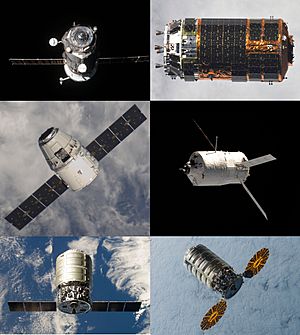
Cargo or resupply spacecraft are robotic spacecraft made to carry supplies. They often support space stations by bringing food, fuel, and other items. This is different from a space probe, which focuses on scientific studies.
Robotic cargo spacecraft have been used since 1978. They have delivered supplies to Salyut 6, Salyut 7, Mir, the International Space Station, and the Tiangong space station.
As of 2023, three different cargo spacecraft supply the International Space Station: Russia's Progress, America's SpaceX Dragon 2, and Cygnus. China's Tianzhou spacecraft supplies the Tiangong space station.
See Also
- Human spaceflight
- Timeline of Solar System exploration


